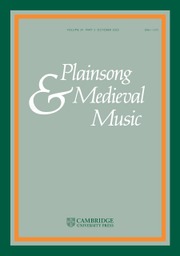No CrossRef data available.
Article contents
Liturgical chant bibliography 12
Published online by Cambridge University Press: 22 October 2003
Extract
Liturgical chant bibliography 12 maintains the traditional division into: (1) Editions and facsimile editions, (2) Books and reprints, (3) Congress reports, (4) Chant journals, (5) Collections of essays and dictionaries, (6) Articles in periodicals and Festschriften. Additions to previous bibliographies, consisting mainly of reviews, follow the present introduction. A significant publication in 2002 was without doubt the colour facsimile of the manuscript Paris, Bibliothèque nationale de France, fonds lat. 776 (12002), an eleventh-century gradual from the Benedictine abbey of Saint-Michel-de-Gaillac near Albi. Although no staff lines are present, the music is notated carefully in diastematic notation. The availability of a facsimile of this famous manuscript will certainly be of value for the study of semiology and the transmission history of tropes, proses and prosulae. It also contains traces of the Gallican and Mozarabic chant repertories.
Information
- Type
- Research Article
- Information
- Copyright
- © 2003 Cambridge University Press

